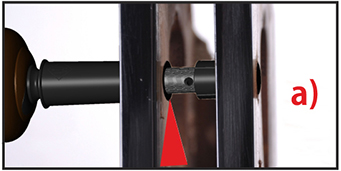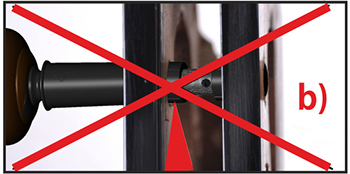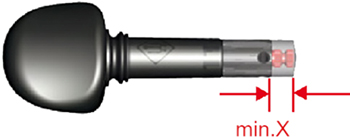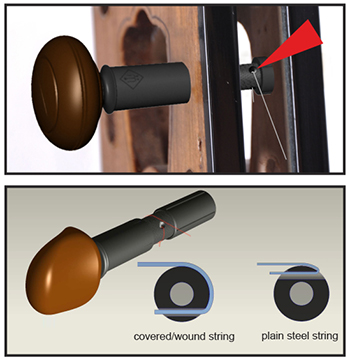
WITTNER® FINETUNE‑PEGS
MADE IN GERMANY
INSTRUCTION MANUAL
WITTNER® FINETUNE-PEGS
for oriental Instruments
Installation instructions
A
Using a standard reamer (1:30) the peg hole is finished so that the WITTNER® Finetune-Peg is positioned as shown under a):

a) Ideal position of the WITTNER® Finetune-Peg: The knurled part should touch the pegbox wall or even reach 1 mm/0,0393" inside the pegbox wall.

b) This position is not favourable because the string may rest on the non-moving part of the shaft causing excessive tension on the string.
1. The WITTNER® Finetune-Peg is manufactured from a composite material and therefore has less friction than a traditional wooden peg.
When fitting in the pegbox the WITTNER® Finetune-Peg will tend to slide deeper into the pegbox.
2. It's most important that all peg paste residue is cleaned from the pegbox and from the WITTNER® Finetune-Peg prior to final fitting.
3. Every single peghole must be checked and treated individually, since every wooden peg fitted previously on the instrument could have a different size than other pegs.
B
The end of the shaft can be shortened and finished as on any ordinary peg (cutting off with a saw, filing a head, sanding and polishing).
The minimum length of the shaft's end must not be shorter than the amounts shown below (see X):

Push the WITTNER® Finetune-Peg with slight pressure into the peghole.
C
Mounting the strings:
The knurled spool has two holes for strings. First one is closer to the head of the peg and suitable for thinner strings with less windings.
Second one which is further away from the head and suitable for thicker strings may be used when many windings are needed.
The strings should be mounted as shown in the following pictures:

D
Tuning:
The WITTNER® Finetune-Peg needs not/must not be loosened or tightened in order to tune the instrument.
The project aiming to develop WITTNER® Finetune-Pegs for Azerbaijani national instruments (Tar, Kamancha and Qopuz)
and Persian instruments (Tar, Kamanche and Setar) was proposed and pre-designed by Mr. Mohammad Amanollahi, Civil Engineer, Professional Musician (Azerbaijani Tar virtuoso),
Azerbaijan National Conservatoire's Student from Toronto, Canada. (Website: www.tar4tar.com, Email: tar4tar@msn.com)
His extensive technical and musical knowledge and commitment combined with our German engineering led to the revolutionary new pegs
which will make it tremendously easier to play and tune these traditional instruments.
Patent:
Germany: DE 10 2007 054 312 A1
USA: USA 7,816,594 B2
China: CN 101868820
and others
<<< To the top
<<< Back to product overview

Wittner – Division of Gewa Music GmbH
D-88316 Isny Phone ++49-7562-7040
SITE NOTICE · DATA PROTECTION